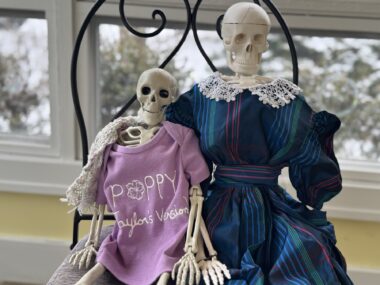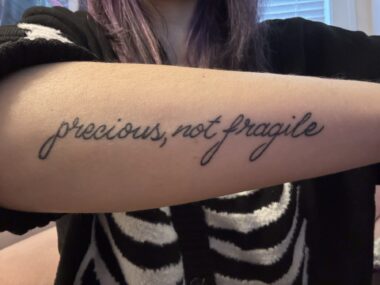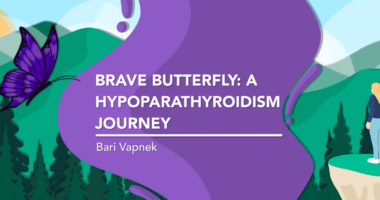Before my hypoparathyroidism diagnosis, I felt it in my bones
In a Bionews debut, tales of learning about and living with 'hypopara' disease

My name is Heather Novak, and I’ve been a surgical hypoparathyroidism (hypopara for short) warrior since 2003 as well as an award-winning LGBTQ+ romance writer. The tale of my journey starts with a skeleton — my actual skeleton, not the fake ones in my living room, pictured below and named Poppy and Ophelia.
“Picture it: Sicily, 1922:” — OK, picture a middle school soccer field, 1996: The 12-year-old me runs onto the field, and 10 seconds later, a soccer ball hits my left arm and breaks it. It takes two days for anyone to realize the arm is broken because bones shouldn’t break that easily.
One year later, my left arm hurts again. I joke that I hope I didn’t break it. But it starts to swell, and an X-ray confirms a fracture. I don’t remember the moment the bone broke. Then came a third broken wrist, followed by a broken toe and a scoliosis diagnosis.

Plastic skeletons Poppy, left, and Ophelia make their home at Heather Novak’s place. (Photo by Heather Novak)
Two years later, in 1999, I was traveling on a train to Paris from London as part of an international theater-organ competition. I woke up that morning sick to my stomach. “I’ll feel better as soon as I get home,” I thought. “I’m homesick.”
I wasn’t homesick.
It took four more years of trips to the emergency room, a Rolodex of doctors, and piles of negative pregnancy tests to get a diagnosis beyond “You’re just nervous!” or “You’re just a teenager!” After I broke down sobbing in my internal medicine doctor’s office, begging for more labs, he finally caught it: my calcium level was extremely high.
I had adenomas (noncancerous tumors) on my parathyroid glands, causing hyperparathyroidism — hypoparathyroidism’s sister disease — which directed my body to send too much calcium from my bones into my bloodstream. My parathyroid glands were having a rave, it seemed, and surgery was supposed to turn the music down.
After a 20-minute surgery turned into an eight-hour, intubated nightmare, I discovered I had only had three parathyroid glands, not the normal four, because of an assumed birth defect. (I was a preemie twin.) Unfortunately, surgery had overcorrected my three-gland condition, and on July 2, 2003, at 18 years old, I woke up from surgery with a new diagnosis: hypoparathyroidism. The rave had gone from too loud to eerily silent.
Just take some calcium, I was told. The fatigue was just because I was still a teenager, I was told. And of course, could I be pregnant? I was asked. The ambulance rides, ER bills, and concerning labs exposed a different reality to the words too often repeated.
Living with hypoparathyroidism
It took 10 years before I found an endocrinologist who specialized in hypoparathyroidism and another year after that to meet someone else with my disease. So much of my mental and physical deterioration was a direct result of a lack of knowledge and community.
I never want anyone else to go through what I did, and I hope my column helps others realize they’re not alone. There’s an entire community waiting to provide support. That community is what gave me back my life.
Finding my medical team and the hypopara family changed everything. My moniker of “that purple-haired girl with hypopara” spread. That carried over into my writing, where I was tired of only healthy, able-bodied people getting happy endings, so I wrote romances with characters who had visible and invisible disabilities.
I’ve now won multiple awards with eight books (and counting) and in 2021 received the honor of becoming one of BEQ Pride’s “40 LGBTQ+ Leaders Under 40.” I’m also living a real-life romance with my spouse, whom I’ll call Mr. Heather, who’s the backbone of my support system.

Heather Novak’s forearm tattoo, which reads, in cursive, “precious, not fragile.” (Photo by Heather Novak)
More recently, in 2023 I was overjoyed — and, let’s be real, terrified — to be the first patient to transition from the Natpara Special Use Program (designed to help people after Natpara, a parathyroid hormone injection, was discontinued) to the TransCon PTH Expanded Access Program (now Yorvipath, a brand name for palopegteriparatide, a hormone replacement therapy).
The day I received my first commercial shipment of Yorvipath and officially closed out the trial was the day I received the job offer to work for Hypoparathyroidism News. The universe has incredible timing.
Through this journey, I’ve discovered something I know deep in my bones: I’m precious, not fragile. Sure, my bones break easily, my calcium levels can drop if I laugh too hard, and I can’t even sniff Champagne (though I do stare at it longingly with big heart eyes). But I’ve fought for my life repeatedly and tried to save others along the way. I’m precious, like 24-karat gold, not fragile as a thin sheet of ice.
To remind myself, I got the phrase tattooed on my forearm. It’s also a secret fangirl reference to something a dear friend wrote about loving someone with a chronic condition.
Hypopara is scary, but I hope that through sharing my story, I can spread awareness, support, comfort, and humor. Maybe a tiny bit of weird, too!
Note: Hypoparathyroidism News is strictly a news and information website about the disease. It does not provide medical advice, diagnosis, or treatment. This content is not intended to be a substitute for professional medical advice, diagnosis, or treatment. Always seek the advice of your physician or another qualified health provider with any questions you may have regarding a medical condition. Never disregard professional medical advice or delay in seeking it because of something you have read on this website. The opinions expressed in this column are not those of Hypoparathyroidism News or its parent company, Bionews, and are intended to spark discussion about issues pertaining to hypoparathyroidism.








Leave a comment
Fill in the required fields to post. Your email address will not be published.